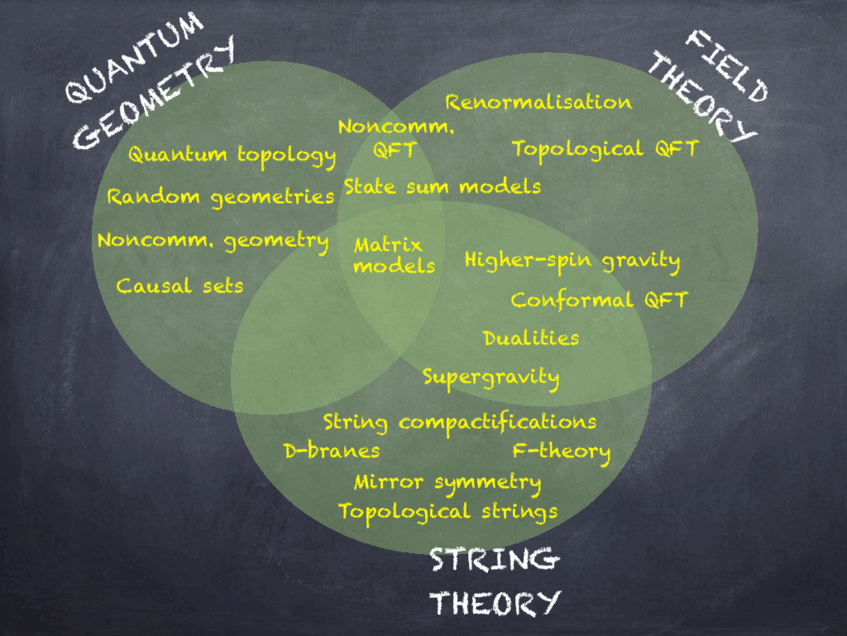Our research
The research pursued in the Mathematical Physics group deals with the mathematical structures of fundamental interactions including approaches to quantum gravity. It covers a range of topics in field theory, quantum geometry and string theory.
In physics, we have by now acquired a deep understanding of the interactions that apparently govern all processes that we observe in the universe. The fundamental interactions have been identified as the electromagnetic, weak and strong nuclear force, and gravity. Whereas gravity is described by Einstein's theory of general relativity in terms of a curved space-time geometry, the other forces are described by quantum field theories. Although highly developed, there are still many fundamental (physical and mathematical) questions within these theories which remain open. Even more unsatisfactory is the fact that quantum field theory and general relativity do not seem to be compatible; we are missing a theory of quantum gravity that could unify these descriptions. As gravity is concerned with the geometry of space-time, it is the geometry itself that is expected to show quantum behaviour. This means that at the fundamental level, we do not know what space and time really mean, and they are likely to be replaced by a more fuzzy ''quantum geometry''.
There are different approaches to quantum gravity; some of them concentrate on generalisations of geometry like noncommutative geometry or quantum topology, and others try to extend gravity (and the other interactions) into a larger framework like string theory, supergravity or matrix models, to address the issue of quantisation there.
In our group we approach these fundamental questions in different, but often intertwined research directions including
- string theory and Calabi-Yau spaces
- higher-spin gravity and holography
- non-relativistic supergravity
- matrix models and the quantum structure of space-time and gravity
- topological and conformal quantum field theory
- quantum algebra and quantum topology

On-going projects
Phases of Quantum Field Theories: Symmetries and Vacua
Principal investigator: Marcus Sperling
Scientific staff: Sinan Moura Soysüren (PhD)
FWF START Award (STA 73)
Start: October, 2023 - End: September, 2028
Abstract:
Quantum field theory (QFT) is a framework used in theoretical physics to explain various physical phenomena, ranging from the smallest subatomic scales to the larger scales of our universe. While QFT has been successful in many ways, there is still much we do not understand about it. To address this, we rely on a simplified version called supersymmetric QFTs, which allows us to study specific aspects of QFT in a controlled manner, similar to a laboratory experiment.
Supersymmetric QFTs are characterised by their vacua (ground states) and symmetries. Vacua play a crucial role as they determine the phase of the system by defining what particles can exist. There are two types of vacua: Higgs and Coulomb. Symmetries, on the other hand, define the rules for motion and interaction of the particles.
In my recent research, I made some exciting discoveries that challenge our current understanding of Higgs vacua. Surprisingly, I found that Higgs vacua exhibit unexpected quantum behaviours. To analyse these phenomena, I developed a specialised program called "magnetic quivers," inspired by Coulomb vacua in three dimensions. Coulomb vacua are known for their challenging quantum effects, but recent breakthroughs have helped us make significant progress in understanding them. Building upon these insights, the magnetic quiver program provides a powerful algorithm and exact computational techniques to explore quantum Higgs vacua. Using this program, I can determine the exact spectrum (i.e. what particles exist), identify the symmetries involved, and even create phase diagrams.
This project has three main objectives. First, I aim to classify all the quantum Higgs vacua in six-dimensional supersymmetric QFTs, which hold a pivotal role in the realm of supersymmetric quantum field theories. This will lay the foundation for a systematic study of QFTs across different dimensions, not just in six space-time dimensions. Second, I will focus on the emerging three-dimensional Coulomb vacua and analyse the underlying mathematical structure of these new quantum vacua, which sheds light on the new rules governing the quantum behaviour. Lastly, by combining vacua, magnetic quivers, and defects, I will explore a novel direction: studying four-dimensional QFTs that can be realised as defects in six-dimensional supersymmetric QFTs. These defects, engineered based on knowledge of the Higgs vacua, support their own four-dimensional QFTs, which can be systematically analysed.
The outcomes of this project will advance both physics and mathematics. In physics, the results will provide unprecedented insights into the quantum Higgs vacua of QFTs in various dimensions. In mathematics, the intuitive QFT techniques offer a fresh perspective on the underlying geometric structures.

Higher defect state sum models
Principal investigator: Nils Carqueville
Scientific staff: Tim Lüders (PhD)
FWF Principal Investigator Projects (P 37046)
Start: October, 2023 - End: September, 2027
Abstract:
Quantum field theory is a central part of a modern understanding of physics, especially elementary particle physics and condensed matter physics. A full understanding would also involve a mathematically rigorous and conceptually clear formulation of quantum field theory. The search for this has been a goal of both theoretical physics and pure mathematics for several decades. Our project is part of this endeavour, aiming for a functorial description of so-called topological state sum models. To achieve this, ideas and results of theoretical physics, category theory and algebraic topology are to be employed to construct a general theory of state sum models as an iterative phenomenon that consistently reduces higher-dimensional aspects to lower-dimensional ones. Moreover, this theory will be applied to establish new relations between known topological quantum field theories, to further develop the representation theory of higher algebras, and to describe anomalies of 3-dimensional theories.

Quantum Spacetime and Gravity in Matrix Models at one Loop
Principal investigator: Harold Steinacker
Scientific staff: TBA
FWF Principal Investigator Projects (P 36479)
Start: October, 2022 - End: October, 2025
Abstract:
Reconciling gravity with quantum mechanics remains to be one of the major open problems in theoretical physics. It is widely expected that this leads to a quantum structure of space-time at short distances, which requires a new framework to formulate physical theories. One promising such framwork is given by certain matrix models, which can be viewed as an alternative approach to string theory. Certain solutions of this model provide a “quantized” cosmological space-time, and its fluctuations provide all the ingredients for gravity. In particular, it was found recently that the dynamics of this “emergent” gravity theory is governed by an effective action which is similar to the one in general relativity (GR), which is the accepted description of classical gravity. However, the matrix model leads to deviations from GR which are expected to be important on cosmic scales, as well as extra degrees of freedom whose physical significance remains to be understood.
The aim of this project is to study and elaborate this emergent gravity theory in detail, and to compare it with general relativity. The first step towards this goal will be a detailed elaboration of the effective action, which results from quantum effects in the matrix model. The leading contribution of these quantum effects – known as one-loop contribution – will be elaborated in detail. This provides the starting point for a systematic analysis of the regime where the emergent gravity is close to GR, as well as the regime where it differs significantly from GR. The cross-over between these regimes will be studied, and the physical implications of the extra degrees of freedom will be clarified. In particular, spherically symmetric vacuum solutions will be studied taking into account these quantum effects, and their relation with the Schwarzschild geometry will be elaborated. Further objectives include stabilization of fuzzy extra dimensions due to vacuum energy, which is important in the framework. Finally, we will attempt to understand the singularity resolution in the center of black holes within the matrix model framwork.

